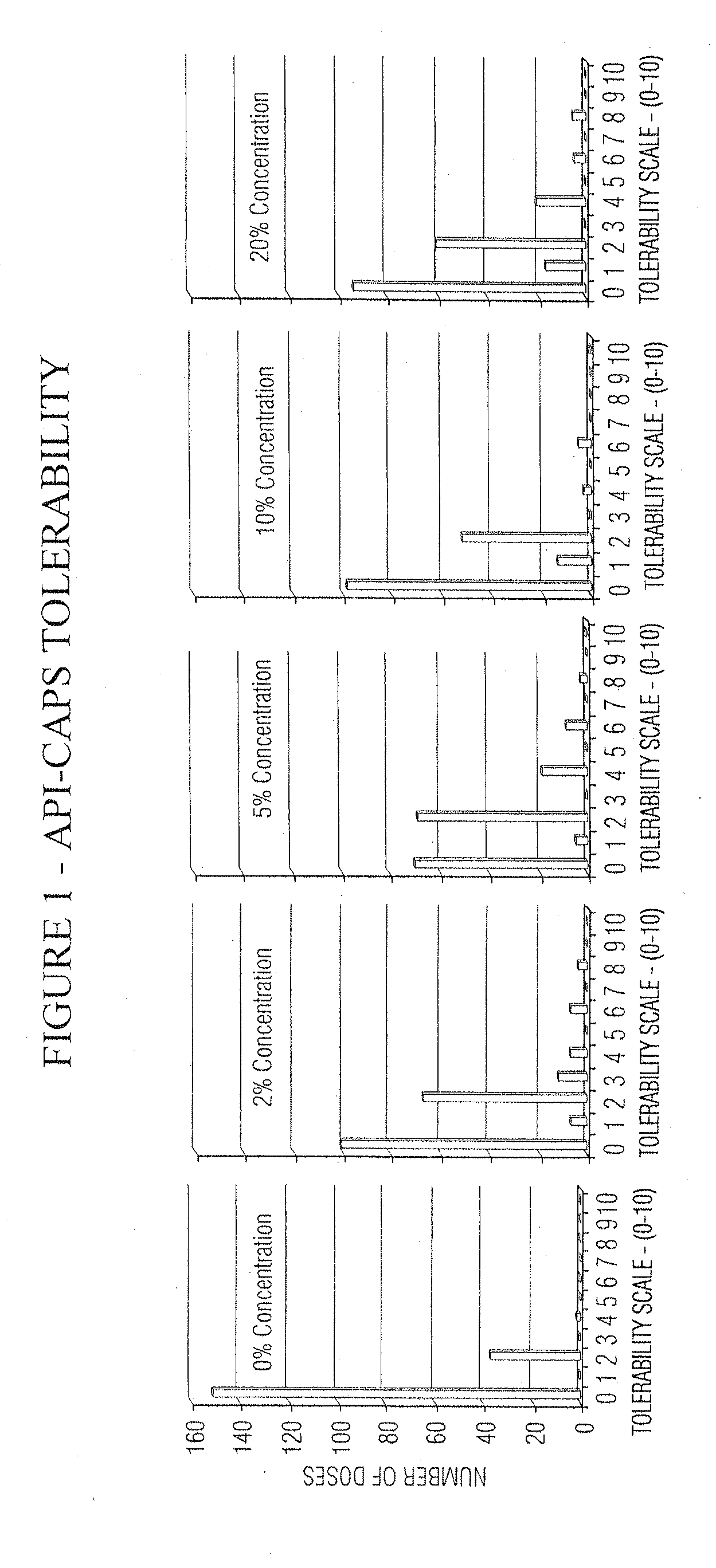Pain relief compositions, manufacture and uses
a technology composition, which is applied in the field of compositions of transient receptor potential vanilloid 1 (trpv1) selective agonists, can solve the problems of inability to achieve pain relief for more than a day or two, and inability to achieve pain relief for a long tim
- Summary
- Abstract
- Description
- Claims
- Application Information
AI Technical Summary
Benefits of technology
Problems solved by technology
Method used
Image
Examples
example 1
Preparation of 100 Grams of the 1.8 wt. % Capsaicin, 0.75 Wt. % Apigenin & White Flower Analgesic Balm Formulation
Form 2A, Table IIIA
Step I
Preparation of the Apigenin / Polysorbate 80 (PS80) Concentrate
[0232]Ingredients Include:[0233]9.25 grams of Super Refined PS80, CRODA, Inc. CAS #9005-65-6[0234]0.75 grams of Apigenin powder, Skyherbs Technologies Co., Lot #0000418019
[0235]Procedure:[0236]1. Add 9.25 grams of the Super Refined PS80 to a 50 cc “Pyrex” beaker.[0237]2. Add 0.75 grams of Apigenin powder to the PS80,[0238]3. Heat the PS80 / Apigenin mixture to a temperature slightly in excess of ˜275° C. At about 200° C., it will be observed that the mixture will take on a light brown / reddish color which will darken when the Apigenin is completely solubilized at ˜275° C.[0239]4. The Apigenin / PS80 solution is set aside and allowed to cool to
Step II
The Preparation of a Liquid Solution of Selected Ingredients
[0240]Ingredients:[0241]88.2 grams of While Flower Analgesic Balm[0242]1.8 grams of...
example 2
Preparation of 100 Grams of the 1.8% Nonivamide / Apigenin Formulation Form 9, Table III
Step I
The Preparation of a Liquid Solution of Selected Ingredients & Capsaicin
[0256]Ingredients:[0257]55 grams of NF grade Methyl Salicylate, Spectrum Chemical, CAS #119-36-8[0258]10 grams of USP grade Camphor, Spectrum Chemical, CAS #76-22-2[0259]1.8 grams of Nonivamide obtained from Aversion Technologies CO.; Bowie, Md., CAS #2444-46-4[0260]20 grams of Ethyl Alcohol, Graves grain alcohol, 190 Proof
[0261]Procedure:[0262]1. Obtain the “tare weight” of a ˜200 cc beaker & add 55 grams of NF grade Methyl Salicylate.[0263]2. Add 10 grams of USP grade Camphor flakes to the mixture of Step 1. Heat the mixture to ˜40° C. to hasten the dissolving of the Camphor flakes while stirring,[0264]3. Add 1.8 grams of Nonivamide to the mixture from Step 2. Heat the mixture to ˜40 to 50° C. to hasten the dissolving of the Nonivamide powder. (Note: Adhere to safety precautions in the handling of the powder.)[0265]4. A...
example 3
Preparation of 100 Grams of the 1.8% Nonivamide / Apigenin Formulation Form, 4 Table III
Step I
Preparation of the Apigenin / Polysorbate 80 (PS80) Concentrate
[0271]Ingredients Include:[0272]9.25 grams of Super Refined PS80, CRODA, Inc. CAS #9005-65-6[0273]0.75 grams of Apigenin powder, Skyherbs Technologies Co., Lot #0000418019
[0274]Procedure:[0275]1. Add 9.25 grams of the Super Refined PS80 to a 50 cc “Pyrex” beaker.[0276]2. Add 0.75 grams of Apigenin powder to the PS80.[0277]3. Heat the PS80 / Apigenin mixture to a temperature slightly in excess of ˜275° C. At about 200° C., the it will be observed that the mixture will take on a light brown / reddish color which will darken when the Apigenin is completely solubilized ˜275° C.[0278]4. The Apigenin / PS80 solution is set aside and allowed to cool to
Step II
The Preparation of the Selected Ingredients & Nonivamide Mixture
[0279]Ingredients:[0280]35 grams of NF grade Methyl Salicylate, Spectrum Chemical, CAS #119-36-8[0281]13 grams of USP grade M...
PUM
| Property | Measurement | Unit |
|---|---|---|
| wt. % | aaaaa | aaaaa |
| particle size | aaaaa | aaaaa |
| melting points | aaaaa | aaaaa |
Abstract
Description
Claims
Application Information
 Login to View More
Login to View More - R&D
- Intellectual Property
- Life Sciences
- Materials
- Tech Scout
- Unparalleled Data Quality
- Higher Quality Content
- 60% Fewer Hallucinations
Browse by: Latest US Patents, China's latest patents, Technical Efficacy Thesaurus, Application Domain, Technology Topic, Popular Technical Reports.
© 2025 PatSnap. All rights reserved.Legal|Privacy policy|Modern Slavery Act Transparency Statement|Sitemap|About US| Contact US: help@patsnap.com



